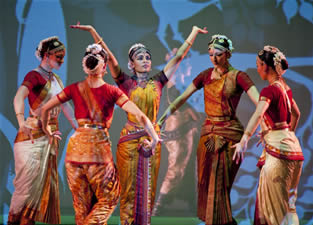Ragamala, a South Indian Bharatanatyam dance company from Minneapolis, turns the Reynolds Theater stage into a mesmerizing village in Sacred Earth, for the company’s first American Dance Festival appearance. The six female dancers are accompanied by a four-person orchestra, which includes a rich-voiced Carnatic singer. The beautiful program will repeat on July 11 and 12.
Ragamala was founded 20 years ago by Ranee Ramaswamy (she and daughter Aparna are co-artistic directors and soloists; another daughter Ashwini is also a soloist), but the ancient forms of Bharatanatyam dance, with its expansive language of gesture and movement, developed in south India over centuries before the Indian diaspora cast it up in such an unlikely new home as Minnesota. Bharatanatyam can seem surprisingly modern, and here the production’s video backdrop component keeps us aware of the 21st century. Drawings in the Warli style by Anil Chaitya Vangad, white on dark grounds, are projected onto backdrops and sheer scrims. Motifs include trees of life, rivers, rice fields, and village rituals, all arranged with relaxed symmetry and many including circular or spiral patterning. Sacred Earth utilizes, and draws imagery from, Tamil Sangam poetry (300 BCE-300 CE). An English version of these fragments is conveniently provided in the program, and intermittently, the texts are spoken in English, as well as being sung in their original language, accompanied by nattuvangam, mridangam and violin. The rhythm is steady, rising and falling like breathing, and the dancers add high and low sounds to the mix with their gentle stamping and the shimmer of their ankle bells.
For many people from Western cultures, the way in to Indian classical dance is through color, and the glories of silk pleated, wrapped and draped over the dancers’ bodies. Certainly, those are important components of the spectacle. In Sacred Earth, each dancer wears a very similar costume, but each has her own color, ranging through the golden and red earth tones, with one the green of rivers and distant mountains. The rich silks are given even greater depth by the way their pleats and folds move and reflect the light differently from their taut expanses, and the colors are further augmented by the red-stained decorations of the bejeweled dancers’ feet, fingers and palms. Although the dancers are almost completely covered, their shapes are well-defined and smoothed into sensuous curves.
Sacred Earth begins with a long, pleasing ritual spreading of rice flour upon the earth. Kolam is a practice of women in southeastern India, who begin each day marking out a pale design, an offering to the Earth Mother, outside their doors. This stage version was designed by Ranee Ramaswamy. In it, five dancers quietly arrange their white flour drawings on the black stage floor, turning around them as they begin to spiral. In the center of their circle, a sixth dancer does the same, a wheel within a wheel. The designs eventually meld into circles within a circle, which becomes the dance ground.
As the dance develops, the storytelling strengths of Bharatanatyam become evident. Even if you’ve never seen any Indian classical dance, you will find some of the gestures immediately clear, and here the use of poetry and painting makes gesture interpretation generally easy (although I’m certain there are levels and levels beyond the easy one). As the evening goes on, this complex art’s many elements — music, rhythm, song, story, poem, prayer, gesture, motion, image, light, color — meld, like “Earth and pouring rain/Mingled/Beyond Parting.”
Ragamala Dance repeats Sacred Earth July 11-12. See our sidebar for details.











